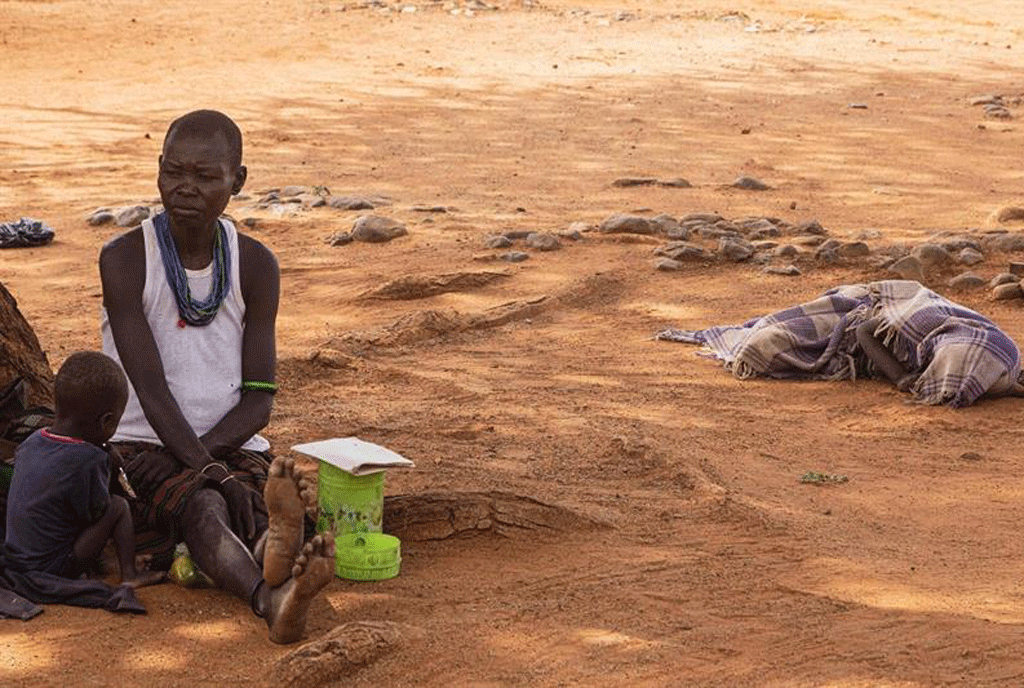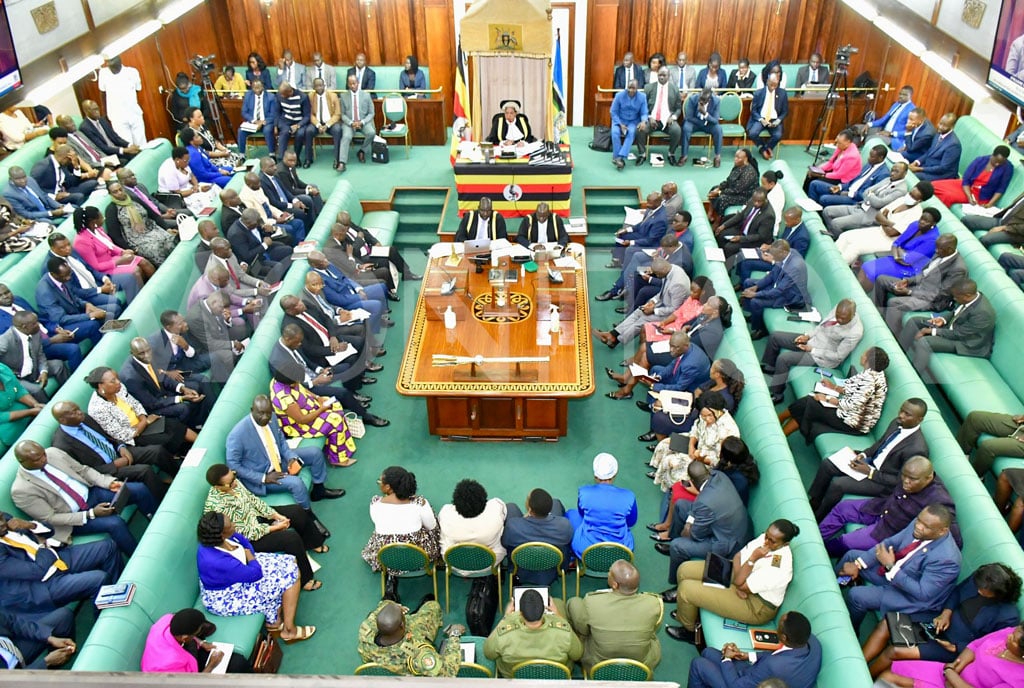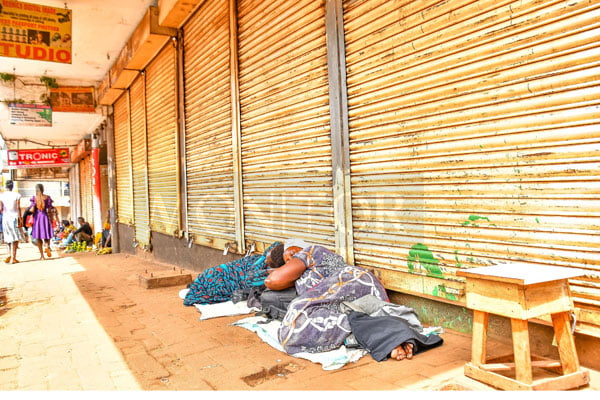Prime
Massive crop failures after weatherman’s false alert

A mother and her children during a nutrition screening at Nadunget Health Centre in Nadunget, Karamoja Sub-region, Uganda, on May 24. In Karamoja and some parts of Lango sub-regions, there are reports of people dying of hunger as a result of food shortage. PHOTO/AFP
What you need to know:
- The Agriculture ministry blames this on the unpredictable weather patterns.
Prices of food commodities are projected to rise further due to a dry spell which has caused a general decline in crop yields.
In an interview with Monitor yesterday, Mr Herbert Kintu, a farmer in Wakiso District, said: “The rainy season was short. When the rain started, I thought it would stay for a long time. We ended up planting late and the drought suddenly began. Crops have withered.”
Mr Kintu said he had planted maize and beans on five acres of land.
“I also have some fruits such as mangoes and oranges that are not doing well because of the drought. In my animal farm, the well where we were getting water has also dried up,” he added.
Mr Kintu, who is also the leader of Wakiso Farmers Association, blamed the issue on the destruction of forests due to the increasing population.
Wakiso has about two million people, up from 908,000 in 2002, according to government statistics.
Mr Denish Ogwang, another farmer in Lira District, said: “The drought has greatly affected farmers. The yields are extremely low. On my farm, I used to harvest more than 400 kilogrammes of red pepper but this time around, I harvested only 300 kilogrammes, even after using fertilisers.”
He added: “But for those who did not use fertilisers, the yields were between 170 and 190 kilogrammes. A kilogramme is sold at Shs11,000. I advise farmers to adopt modern farming practices where we use fertilisers –those that are applied in the soil or on plant leaves. This will increase yield.”
Mr John Bosco Ssekiwunga, a poultry farmer and the leader of Masaka Farmers Association, said farmers are struggling to embrace irrigation because the machines are expensive.
A simple irrigation system goes for between Shs4m and Shs9m, an amount too high in a country with a per capita income of between $840 (Shs3.1m) and $1,045 (Shs3.9m).
“As an association, using support from some donors, we provided farmers with some underground water harvesting tanks. But this is not sustainable if there is a prolonged dry spell,” Mr Ssekiwunga said.
“By now, most of the water farmers stored in their tanks during the rainy season has got finished. We build the tanks using a cost-sharing strategy. The tank holds between 10,000 and 20,000 litres of water. It is very hard to predict that we shall have food next season,” he added.
Mr Ssekiwunga said the price of animal feeds has also gone up because of the rising prices of feeds such as maize bran. A kilogramme of maize bran costs between Shs850 and Shs1,200, up from around Shs600.
According to the Uganda National Meteorological Authority (UNMA), the first rainy season in Uganda tends to run from either February or March to May.
In February, the UNMA projected that between March and May, there was going to be “near normal (near average) to above normal (enhanced) rainfall” over most parts of the country with a high probability of occurrence over some parts of north eastern Uganda.

A farmer inspects his garden. Farmers across the country have raised complaints about the dry spell which they say has destroyed their crops. PHOTO/RACHEL MABALA
When contacted to comment on the accuracy of UNMA predictions, Mr Deus Bamanya, the director of applied meteorology data and climate services, referred us to Mr Abubaker Kalema, a senior meteorologist.
Mr Kalema said he would call back later but had not done so by press time.
Mr Bamanya’s division provides weather advisories to the farming community through weather forecasts and outlooks issued by UNMA, including the monthly climate outlooks and updates.
Maj Gen David Kasura Kyomukama, the Permanent Secretary in the Minister of Agriculture, Animal Industry and Fisheries, said the country should shift from rain-fed agriculture and preserve the environment to minimise climate shocks.
Maj Gen Kasura said what is observed is inconsistent rainfall and not a drought.
“Although this year UNMA quoted normal range, there was inconsistency in the amount of rain. It rained when it should not have rained,” he said.
“So, some people planted poorly and when the rains ended, the crops were affected [because they were not yet mature]. For others, when the rain started, they waited for consistent rain [which didn’t come],” he added.
No famine
Maj Gen Kasura said despite the unpredictable weather patterns, they do not predict the country experiencing famine
“It is true we may receive below-normal yields but we shall not have famine. Last year and even the previous year, we received bumper harvests but this year, I think we shall receive less.”
Maj Gen Kasura revealed that plans are underway to give out at least 200,000 irrigation machines, starting with areas most affected by drought, using a cost-sharing initiative. He said farmers will contribute around half of the price to boost coverage.
“We are ensuring that we have water. That we create resilience in water for production. We are doing this through irrigation. We are partnering with the Ministry of Water and Environment and we are using the internal capacity to ensure we have water,” he said.
“We are handling this at three levels; we are building the huge water systems but those take time but we are also doing the on-farm irrigation system –the small solar-powered irrigation system. But also through National Agricultural Research Organisation (Naro), we are distributing drought-resilient seeds and stalks,” he added.
Irrigation coverage in Uganda is only one percent. The irrigation potential is 1.5m hectares but only 70,000 hectares are irrigated, according to information from the Agriculture ministry.
“Agriculture is linked with climate. Embrace science and technology, you cannot keep praying to God and expect it. Embrace scientists and science and technology. Don’t panic because this situation is going to be handled,” he assured the public.
However, in Karamoja and some parts of Lango sub-regions, there are already people dying of hunger as a result of food shortage.
The Office of the Prime Minister said it is already providing food relief to hungry people in Karamoja.
Rising food prices
Prices of various commodities such as fuel and food items have been increasing since the beginning of the year. The government blamed this on the Ukraine-Russia war.
For example a bunch of matooke which cost Shs15,000 in 2021 now goes for Shs40,000, a kilogramme of rice that cost Shs3,000 last year now goes for between Shs4,500 and Shs5,000 while maize flour has jumped from Shs1,500 to Shs3,000.
“We also have the problem of informal trade where maize from Uganda is being taken to Kenya. If you don’t have controlled trade, you will not have the statistics to regulate the amount that should be exported and what should be kept,” Maj Gen David Kasura Kyomukama, the Permanent Secretary of the Minister of Agriculture, Animal Industry and Fisheries said.
“We are also having challenges in delivery of goods to areas where there is a shortage. If you go to western Uganda, you will find a lot of bananas but you will go to other parts of the country and find scarcity,” he added.




